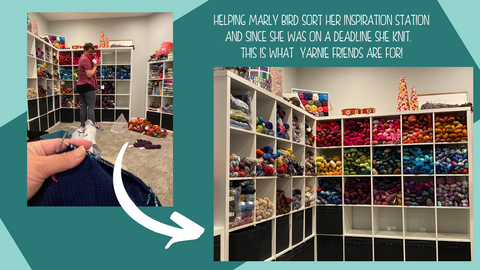Take Your Craft from Hot Mess to Hot Yes!
It's a fact universally acknowledged, that a crafter in possession of a stash, is in search of more time to craft.
It's might be an ugly truth, but if you have your stash and tools organized you have more time to craft.
The same way you know that there are dishes for dinner in the cabinet, and silverware in the drawer, if you know where your yarn in, where your hook or needles are, and where your pattern is, you have more time to stitch. And isn't that the goal after all?
Here's a list of 10 ways to go from Mess to Yes and maximize your knitting or crocheting time.
10. Take the time to organize your yarn. It doesn't have to be in a fancy bin, or organized in rainbow order (I don't even have any red yarn, so that clearly wouldn't work). Organize it by weight of yarn. You are not likely to need a worsted weight yarn and a fingering weight yarn in the same project. Within your yarn weight divisions, organize by color or by project. If you have a project in mind already for that yarn, put it together with the pattern, so that later you aren't staring at it wondering, "What was I going to make?!" All of that wondering what to make time, could be much more efficiently spent, oh, I don't know, knitting or crocheting.

9. Organizing can be social. Though this might not be the time to lean on a significant other who does not share your love of all things yarn, this is the PERFECT time to call a yarnie friend or two and have them help you organize your stash. Because everyone sees organization a different way, you might learn something you hadn't thought of from said friend. Maybe they know a great sock pattern for that yarn, in which case, create that crafting queue. Maybe they are super good at organizing books or magazines in a way you haven't seen. And let's be honest, your yarnie besties aren't going to judge your mess or disorganization. It's a time to play with yarn and hang out with your friends. Also, it is always easier to organize someone else's stuff. I do it for my friend Marly, my sister does it for me, etc. An outside opinion can be super helpful when you are trying to get organized. And the best part, is you can then help your yarnie friends do the same.

8. Take the time to organize your tools. Let's face it. There are probably 100s of stitch markers I have either lost to my couch cushions or vacuumed up in my lifetime, but I do have a place to put the ones that survive. That said, knowing where your tools are is a key to making sure you aren't wasting money on things you already have but can't find. (Unless you replace it, then you can find said lost item immediately.) Go ahead and find a way to organize your knitting needles, your crochet hooks, and your notions so that they are all together when you want to start, work on, or finish a project. You can put your hooks in one cup, a KnitPack DPN/Crochet, or Hook-a-me.

Tame the chaos of your knitting needles with a KnitPack for which ever knitting needle malady plagues you.
7. Keep like things together. You might not have a dedicated stash room or craft space, but that doesn't mean you can't keep things together. When storing yarn or works in progress make sure that extra yarn is stored in a way that is quickly identifiable. So if you are knitting out of a sweater bag, keep your extra skeins of yarn stored in a matching sock bag or stash finder. This way should you need a significant other who doesn't craft to retrieve your needed extras, you can say, grab the bag that looks like X or, it's the one that matches the one I am knitting out of.
6. Have a "go to" project handy. There is nothing worse that trying to rush out of the door to a place you know you are going to sit and wait (traffic, dance, sports practice, etc) and not having your project quickly accessible. Grab a sock bag or a twofer for your project and add it to your key fob to make sure that your project is not only handy, it's always with your keys should you need to dash because you are running late.
Or just keep a project in the car with you at all times. A bucket tote is perfect to fit in the floorboard of your car while still leaving you let room. Better yet, when someone else, is driving, you have the perfect knitting or crocheting seat!
5. Create a crafting queue. If you have ever decided you wanted to start a new project, but wasn't sure what you wanted to knit or crochet, congratulations you are totally normal! However, you standing in front of your (now very organized stash) and wondering what to make, or falling down the Ravelry pattern search hole is all time you could spend knitting or crocheting. That said that means that when you have an idea, maybe you saw it in a Facebook group, at your local stitch and bitch, a friend told you about an awesome new pattern, or maybe you want to do a KAL after the final piece is released, take the 5 minutes you need to go grab your yarn, write down or print out the pattern, and store all of those things together (can I recommend a Stash Finder? They are very handy.) Then the next time you have cast on fever, you don't have to waste time that ends up meaning you don't actually get to cast on, you can just pick a project and get started.
4. Don't crush your patterns. In the digital age, there are so many apps for patterns, and charts, but when it comes down to it, you have to have a way to keep your patterns organized if you print them or even if you don't. If you are a digital pattern lover, make sure that your patterns are clearly named, have a dedicated folder on your computer or in the cloud, and make sure you know they are not corrupted files. A duplicate of that folder of patterns in a backup drive is also a VERY smart idea.
I am still a paper and pencil person. I love a real book, and when I work a chart, I need to cross the rows off or my dyslexia is not going to let me have anything stitched that makes any kind of sense. If you are a person who loves a paper pattern like me, make something that keeps it all organized. A three-ring binder and some page protectors keep the ones you are not currently using safe, while a pattern keeper will go wonderfully in your bucket or barrel with your work in progress. Either way, your pattern is nice and crisp so you don't have to worry about missing a part of a chart pattern to a wrinkle. Ask me how I know this is important.

3. Protect your Finished Objects. When you finish a sweater, scarf, shawl, pair of socks, whatever, it pays to make sure that it is protected from dust and the dreaded moth. (We survived the mothpocolypse of 2018, but 4 pairs of wool socks did not) This is also a great way to keep the left over yarn that matches the project with it in case you ever need to repair anything. There is nothing worse than finding a hole in a sweater or a dropped stitch in a shawl after it's all finished. Having that extra yarn with the project means that you can keep your hand knits and hand crocheted projects looking wonderful for much longer. I use a stash finder for the easier to fold things, and a sock bag full of my sock remnants in my sock drawer since, well, socks get worn more than sweaters when you live in the south.
2. Reduce your duplicates. When your stash and tools are organized and you know where everything is, you are less likely to buy the same thing twice. How many sets of size 5 circulars do I have? Countless, because I didn't know they were in WIPs, or I just plain couldn't find them. But every pair of size 5 needles could have been money toward that hand dyed yarn I wanted for that sweater I loved. This keeps things from being bought more than once for no reason. Do I need more than one set of size 5 knitting needles, DUH! YES. But do I need 25 sets, probably not. Again, this keeps you from spending money on things you already have that could be spent on things you want.
1. Keep a crafting journal. This is a great idea for any kind of craft. If you write down what you did, you can reproduce it should you want to make the same pattern up a second, third, fourth, or fifth time without having to pull out that sweater and count the decreases on the sleeve or measure the length from the waist. (There is no judgement here.) But more than that, keeping a crafting journal also allows you to keep a memoir of your crafting life. This is particularly helpful on days when the lace is terrible, the yarn is tangled, your stitch count is right, but nothing is working. That journal might have the tip you need, it might just be a light at the end of a tunnel, or it can be where you tell that pattern exactly what you think. But a journal is also a lovely thing because if you gift your handwork to others, you have a record of all the things you have made even if they aren't in your possession. (Also, having your care instructions handy for those lovingly made and given gifts is always a good backup plan.)
You can use a planner, a google doc, or just a series of post cards in a recipe box, but all of that means that if you need to reproduce a project, you have a road map of all your changes.











Leave a comment